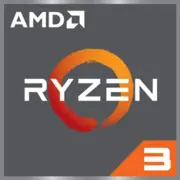AMD Ryzen 3 PRO 1300

AMD Ryzen 3 PRO 1300: Budget Workhorse for Basic Tasks in 2025
Introduction
AMD's Ryzen PRO series processors have always been positioned as reliable solutions for business and everyday tasks. Even years after its release, the Ryzen 3 PRO 1300 (Summit Ridge) continues to attract users who need an affordable yet stable CPU. By 2025, this chip may not be cutting-edge for gaming or heavy workloads, but it retains its niche. Let’s explore who might benefit from this processor today and how to integrate it into a system properly.
1. Key Specifications: Architecture and Main Features
Summit Ridge Architecture
The Ryzen 3 PRO 1300 is built on the first-generation Zen microarchitecture (2017). It is a 4-core/4-thread processor with a base frequency of 3.5 GHz and a maximum frequency of 3.7 GHz. The manufacturing process is 14 nm, which, by 2025 standards, seems outdated (modern chips are produced at 5–3 nm). However, it is sufficient for basic tasks.
Cache and TDP
- L3 Cache: 8 MB (shared across all cores).
- TDP: 65 W — energy efficiency remains a strong feature.
Performance
- Geekbench 6: 1076 (single-core), 3002 (multi-core).
For comparison: Ryzen 5 5500 (Zen 3, 6 cores) scores around ~1600/6000 points.
Features
- SenseMI: A set of technologies for optimizing power consumption and frequencies.
- AMD GuardMI: Protection against physical attacks (useful for corporate systems).
- ECC Memory Support: Important for workstations where stability is critical.
Real-World Example: In 2025, the Ryzen 3 PRO 1300 is commonly used in office PCs for document work and video conferencing. For example, in Company X, the processor is paired with an SSD and 8 GB of DDR4, ensuring smooth operation of Windows 11.
2. Compatible Motherboards
AM4 Socket
The processor uses the AM4 socket, supported by motherboards with the following chipsets:
- A320/B350/X370 (300 series generation).
- B450/X470 (BIOS update required for proper operation).
Selection Tips
- A320: Budget option without overclocking (e.g., ASUS Prime A320M-K, $60–$70).
- B350/B450: Supports overclocking and offers more ports (MSI B450 Tomahawk Max, $90–$110).
Important: Some newer motherboards from 2023–2025 (e.g., with B550/X570 chipsets) are physically compatible with AM4 but do not support the Ryzen 3 PRO 1300 due to a lack of microcode in the BIOS.
3. Supported Memory
- Type: Only DDR4 (DDR5 and LPDDR5 are not supported).
- Frequencies: Up to 2666 MHz (officially), but many motherboards can overclock to 2933–3200 MHz.
- Modes: Dual-channel for enhanced performance.
Recommendations: Optimal choice is 2×8 GB DDR4-2666. For example, Kingston Fury Beast (around $50 for the kit).
4. Power Supply: Calculation and Recommendations
With a TDP of 65 W, even a budget power supply rated at 400–450 W is sufficient. However, consider:
- Additional Components: Graphics card (e.g., GTX 1650 requires 75 W), SSD, HDD.
- Upgrade headroom: If a more powerful GPU is anticipated, choose a PSU rated at 500–600 W.
Examples:
- Be Quiet! System Power 10 450W ($55) — for systems without a discrete graphics card.
- Corsair CX550M ($70) — with headroom for a GPU like the RTX 3050.
5. Pros and Cons
Pros:
- Low Price: $80–$100 (new units available in 2025).
- Energy Efficiency: Suitable for compact builds.
- Reliability: Absence of SMT (Simultaneous Multithreading) lowers the risk of overheating.
Cons:
- Outdated Architecture: Lags behind even budget chips from 2025 (e.g., Ryzen 3 8300G).
- Limited Multitasking: 4 threads are insufficient for rendering or streaming.
6. Use Cases
- Office Tasks: Working with Excel, Word, and browsing (10–15 tabs).
- Multimedia: Watching 4K video (with hardware decoding via GPU).
- Light Gaming: CS2, Dota 2, and GTA V at low settings (with a graphics card like GTX 1050 Ti).
Real Example: A user from Brazil built a PC with Ryzen 3 PRO 1300 and RX 6400 to play Fortnite (1080p, 60 FPS).
7. Comparison with Competitors
- Intel Core i3-7100 (Kaby Lake): 2 cores/4 threads, 3.9 GHz. Cheaper ($50–$60) but weaker in multi-threaded tasks.
- Ryzen 3 3100 (Zen 2): 4 cores/8 threads, 3.9 GHz. 30% faster in multitasking but more expensive ($120).
Conclusion: The Ryzen 3 PRO 1300 outperforms counterparts from 2017–2018 but falls short against modern budget CPUs.
8. Practical Assembly Tips
1. Motherboard: Choose B450 for easy future upgrades to Ryzen 5 5600.
2. Cooling: The stock cooler is sufficient, but for quieter operation, consider the DeepCool GAMMAXX 400 ($25).
3. Storage: An SSD is essential (e.g., Kingston A400 480 GB, $35).
4. Graphics Card: For gaming — GTX 1650 or RX 6400.
9. Final Conclusion: Who is the Ryzen 3 PRO 1300 Suitable For?
This processor is worth considering in three scenarios:
1. Budget Office System: When a PC is needed for working with documents and Zoom.
2. Backup Computer: For home or small business, where reliability is more important than speed.
3. Educational Projects: Assembling PCs for schools or courses.
Why in 2025? Despite its age, the Ryzen 3 PRO 1300 remains one of the most affordable 4-core CPUs with DDR4 support and modern OS compatibility. If your budget is limited to $300–$400 for the entire build, it is a sensible choice. However, for gaming or video editing, it's better to add $100–$150 to secure a Ryzen 5 5500.
Price: $80–$100 (new units, April 2025).
Alternatives: Intel Core i3-10100F ($110), Ryzen 3 4100 ($90).
Basic
CPU Specifications
Memory Specifications
GPU Specifications
Miscellaneous
Benchmarks
Compared to Other CPU
Share in social media
Or Link To Us
<a href="https://cputronic.com/en/cpu/amd-ryzen-3-pro-1300" target="_blank">AMD Ryzen 3 PRO 1300</a>